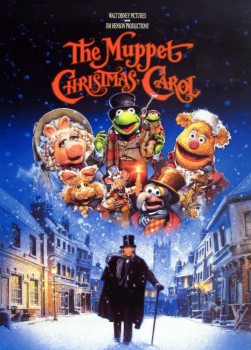Why The Muppet Christmas Carol “Feels Like Christmas”
The only story more associated with Christmas than Charles Dickens’ A Christmas Carol takes place in a manger more than 2,000 years ago. The 1843 novella has a timeless message and an irresistible charm that made it an immediate success and secured its place in the cultural canon; it is a place so prominent that there are hundreds of versions available for us to enjoy during our post-Thanksgiving binge of holiday pop culture. There are the straight retellings like MGM’s 1938 adaptation starring Reginald Owen and 1970’s musical version, Scrooge, which featured Albert Finney in the title role. And for every one of these serious adaptations there is one that approaches the story with a far lighter tone such as 1988’s Scrooged with Bill Murray or the very first Christmas special – Mr. Magoo’s Christmas Carol which originally aired in 1962. In fact, everyone from Lionel Barrymore to Mickey Mouse has put his own spin on this classic story of reclamation and holiday cheer and everyone has their favorite version of the holiday ghost story. Of all the versions available, my personal favorite is 1992’s The Muppet Christmas Carol which, despite starring a amphibian, should be a staple of your family’s holiday viewing.
There is a lot to love about the movie. Michael Caine, who never once gives the indication that most of his costars are made of felt, plays a fantastic Scrooge as cold and ruthless at the beginning of the movie and playful and joyous at the end as any of the other great actors who have played the part. Most of the other characters are played by the classic Muppets who we know and love and who play their roles while maintaining their own quirks; quirks that not only endear them to us, but also seem custom fit to the characters. The soundtrack is fantastic. Songs like “Marley and Marley” and “If Feels Like Christmas” are great fun while others like “When Love is Gone” (absent from some cuts of the film) and the highly affective “Bless Us All” provide some serious emotional heft. The sets are beautiful, the puppetry inspired and the jokes endearingly off-beat.
What really sets The Muppet Christmas Carol apart though is the masterful way that it balances the gravity of Dickens’ story with all of the lighthearted fun we expect from The Muppets. Nowhere in the film does this balance work better than in narration provided by Gonzo (a.k.a. Charles Dickens) and Rizzo. Quoting Dickens’ eloquent prose as often as they are wisecracking, the two classic Muppets guide the audience seamlessly through the constantly changing tones and pace of the story, transitions that some other adaptations struggle to make effectively. As a result, Dickens’ melodrama, with its emotional highs and lows, retains its impact, and the beauty of the original text shines through. And even in their disappearance during the visit to Scrooge’s future, Gonzo and Rizzo are helping to narrate the story by establishing that these key moments, the source of great horror for Scrooge and the climax of the story, must speak for themselves.
In one particularly well-done scene, the Cratchits are dealing with the death of Tiny Tim and Kermit in his role as Bob delivers a de facto eulogy for his youngest son as his family, made up of pigs and frogs mourn. And maybe it’s the technical elements of the film, maybe I’m just a sucker for melodrama or maybe Brian Henson and the talented people at Jim Henson Productions were tapping into their own sense of profound loss, but in this scene, it doesn’t matter that I am watching frogs and pigs made of fabric; the emotion is striking and real. A few minutes later, I’m laughing and Gonzo and Rizzo as they are flung from Scrooge’s window – this is what makes The Muppet Christmas Carol essential holiday viewing.



